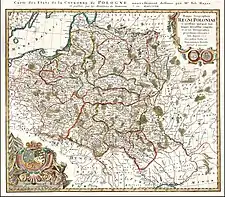Galician Soviet Socialist Republic
The Galician Soviet Socialist Republic (Russian: Галицкая Социалистическая Советская Республика, Г.С.С.Р.) was a Bolshevik's self-declared and short-lived political entity that existed from 15 July to formally 21 September 1920. The communist state was established during a successful counter-offensive of the Red Army in the summer of 1920 as part of the Polish-Soviet War and in the course of which the Polish-Ukrainian joint military force (Polish Ukrainian Front) was forced to retreat from its positions along the Dnieper that it secured earlier in 1920 all the way to the foothills of the Carpathian Mountains.
Galician Soviet Socialist Republic Galitskaya Sovetskaya Sotsialisticheskaya Respublika | |||||||||||
|---|---|---|---|---|---|---|---|---|---|---|---|
| 1920 | |||||||||||
 | |||||||||||
 | |||||||||||
| Status | Unrecognized state | ||||||||||
| Capital | Ternopil | ||||||||||
| Government | Revolutionary Committee (provisional) | ||||||||||
| Chairman | |||||||||||
| Historical era | Interwar period | ||||||||||
• Established | 15 July 1920 | ||||||||||
• Disestablished | 21 September 1920 | ||||||||||
| |||||||||||
| Today part of | |||||||||||
Part of a series on the |
|---|
| History of Poland |
 |
|
|
Part of a series on the |
|---|
| History of Ukraine |
|
|
Description
The republic became a buffer zone of the ongoing conflict within the area of the South-Western front of the Red Army. Due to the successful offensive in July 1920, the Soviet government also created the Polrevkom and had intentions of creating the Polish Socialist Soviet Republic. A similar, but less elaborate activity, of the communist Polrevkom, was related to the North-Western front of the Red Army (the "government" was seated in Białystok).
The Galician SSR was established on 15 July 1920 when the Galician Revolutionary Committee (Halrevkom), a revkom (provisional government) headed by Volodymyr Zatonsky (Vladimir Zatonsky) and created on 8 July in Kyiv under the auspices of the Communist Party of Bolsheviks of Ukraine (CP(b)U), issued its declaration.
The communist government moved to Tarnopol (today Ternopil) in Eastern Galicia on 1 August 1920 upon occupation of the region by the Red Army. The same day the Halrevkom adopted a decree "About establishing of Soviet power in Galicia". The national languages (of equal status) were declared to be Polish, Ukrainian and Yiddish. With its decrees, the communist government abolished private ownership of the means of production, established an eight-hour workday, separated church from state and nationalised church estates, established a single labour school with seven-year education, and nationalised the land. By the end of August, the Halrevkom tried to conduct elections to establish a permanent Soviet government and convene the All-Galician Congress of Soviets.
With the Polish offensive on 15 September, those plans failed and the Halrevkom withdrew from Tarnopol. On 21 September 1920, the republic was officially abolished and its revolutionary committee was transformed into the Galician Bureau of the Central Committee of the Communist Party of Ukraine. With the signing of the Peace of Riga in March 1921, the bureau was liquidated.
Halrevkom did not control the most important area of East Galicia: the Lviv area with its oilfields of Boryslav and Drohobych.
Government composition
- Volodymyr Zatonsky – chairman
- Mykhailo Baran – deputy chairman
- Fedir Konar – head of departments of justice and interior
- Kazimierz Litwinowicz – secretary
- Ivan Nemolovsky – commissar of finances (later head of the department of railways)
- Myroslav Havryliv – commissar of enlightenment
- Mykhailo Kozoris – commissar of courts
- Omelyan Paliiv – commissar of military
- Ivan Siyak – secretary of the Sovnarkom (Council of commissars)
Further reading
- Davies, Norman, White Eagle, Red Star: The Polish-Soviet War, 1919-20, Pimlico, 2003, ISBN 0-7126-0694-7. (First edition: St. Martin's Press, inc., New York, 1972)
External links
- Halrevkom at the Encyclopedia of History of Ukraine
- Galician Socialist Soviet Republic at the Encyclopedia of History of Ukraine